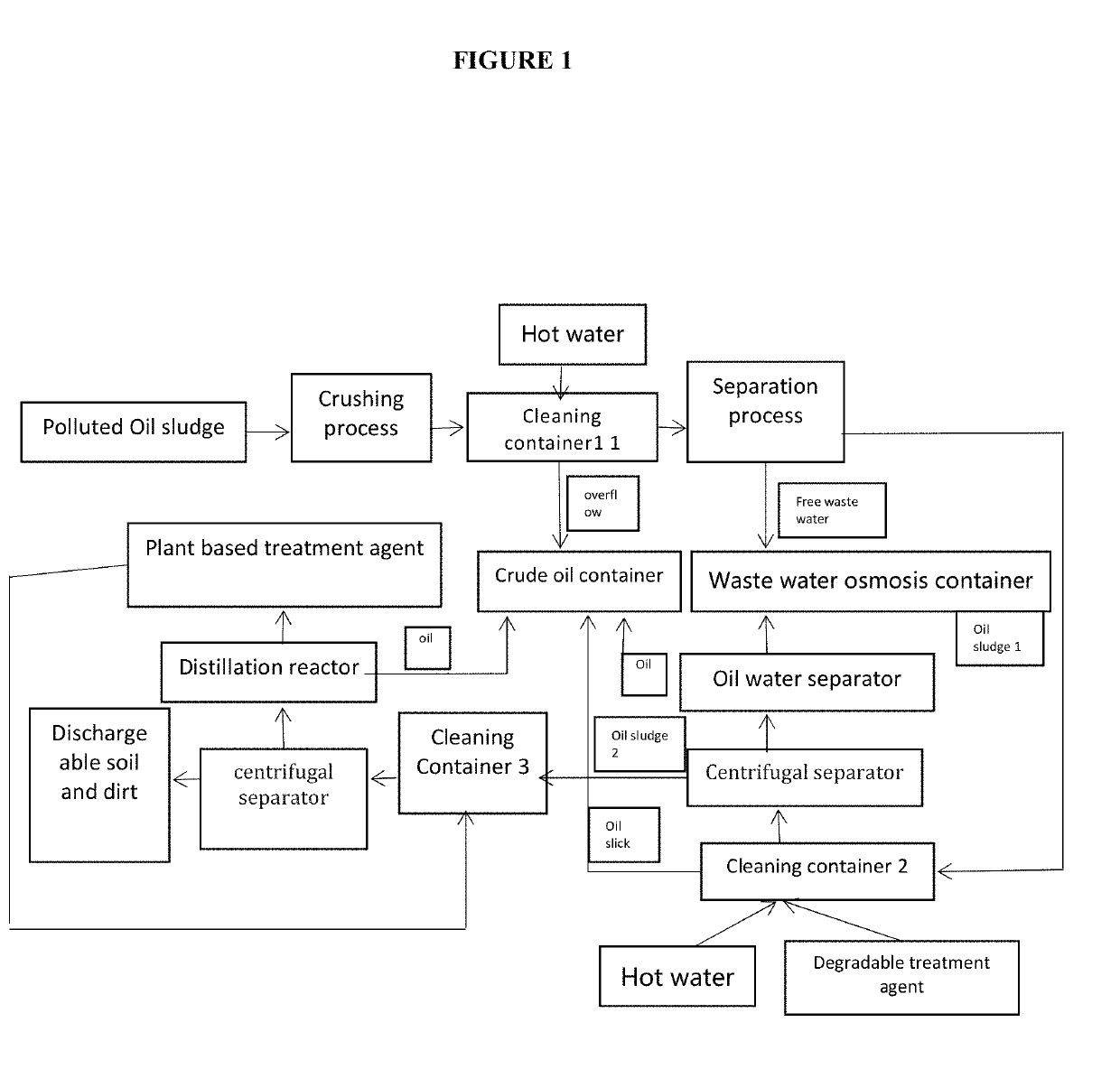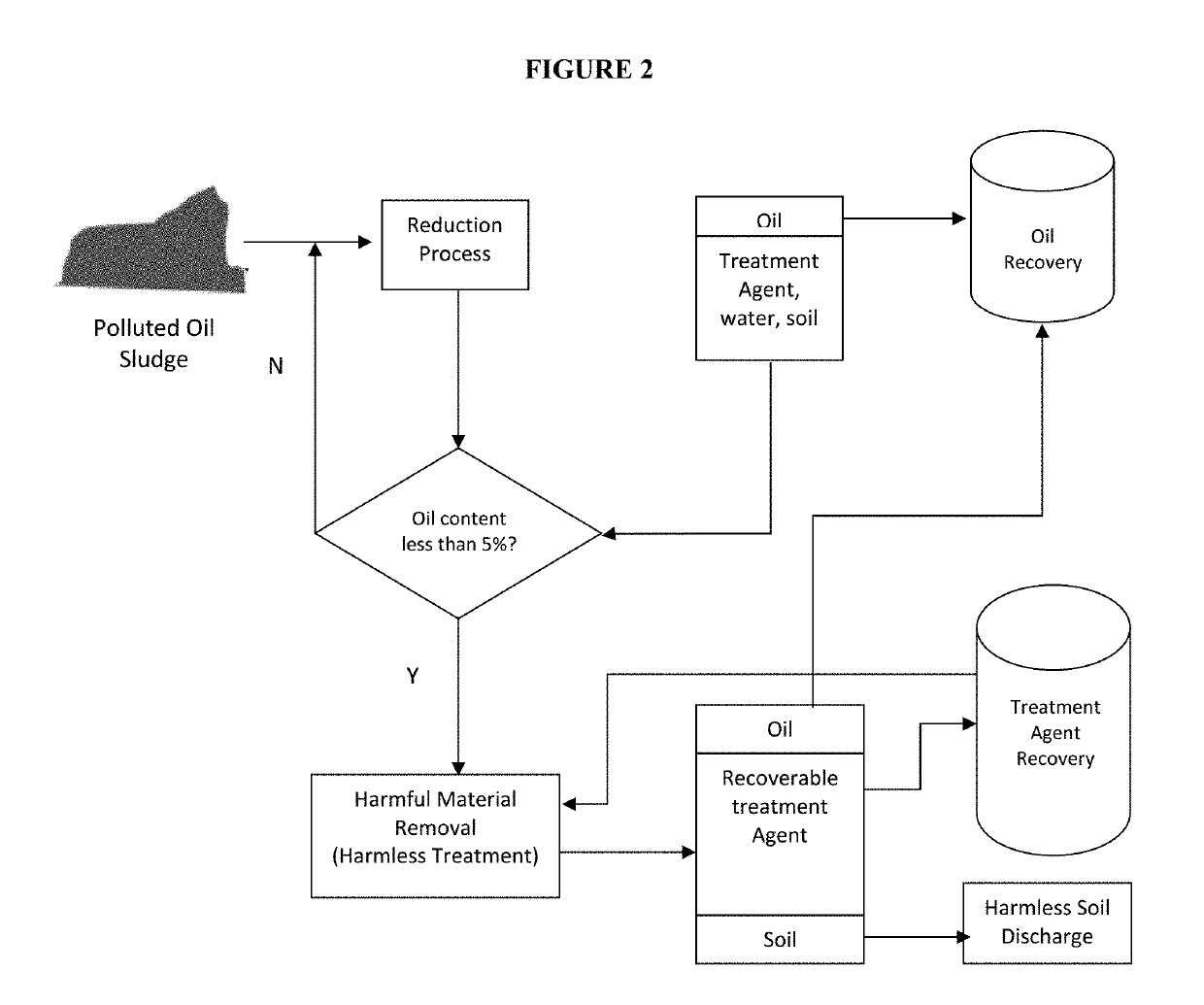Treatment Process for Polluted Oil Sludge
- Summary
- Abstract
- Description
- Claims
- Application Information
AI Technical Summary
Benefits of technology
Problems solved by technology
Method used
Image
Examples
example 1
[0059]Tank bottom sludge of an oil depot is treated in this example. The sludge selected is a viscous black substance with certain fluidity. Crude oil and water envelop the sediment. The material system is uniform. The oil content of the sludge is 58.67%, and the water content is 20.13%. The rest of the content is sediment.
[0060]A treatment method per the present invention is used, which comprise the steps as shown in FIG. 2 (Basic Flow Chart), and use basic assembly of systems and equipment as shown in FIG. 1. More specifically, the treatment is discussed in more detail below.
[0061](1) Pick out the larger stones, plastic trash, tree branches, and other waste materials from the oil sludge sample. Using a screw feeder, the sludge is pushed into a mixing and cleaning tank filled with a certain amount of water in advance at a certain propulsion speed. The ratio of material to liquid is 1:3, stirred at 600 r / min and the mixture is heated to 70° C. After 60 minutes, stirring is stopped a...
example 2
[0067]Oil field oil sludge is used in this example. The sludge selected is a viscous black substance with little mobility. The sludge contains 67.2% of oil, 10% of water, and the rest is silt.
[0068]A treatment method per the present invention is used, which comprise the steps as shown in FIG. 2 (Basic Flow Chart), and use basic assembly of systems and equipment as shown in FIG. 1. More specifically, the treatment is discussed in more detail below.
[0069](1) Pick out the larger stones, plastic trash, tree branches, and other waste materials from the oil sludge sample. Using a screw feeder, the sludge is pushed into a mixing and cleaning tank filled with a certain amount of water in advance at a certain propulsion speed. The ratio of material to liquid is 1:1, stirred at 600 r / min and the mixture is heated to 70° C. After 60 minutes, the stirring is stopped and the materials are allowed to stand for 15 minutes. After stratification, the oil is surfaced as slick and discharged by overfl...
example 3
[0075]Oil sludge of an oil refinery is used in this example. The sludge selected is a viscous black substance with no mobility, fine and uniform particle size, with no impurities. The sludge contains 40.2% of oil, 50% of water, and the rest is silt.
[0076]A treatment method per the present invention is used, which comprise the steps as shown in FIG. 2 (Basic Flow Chart), and use basic assembly of systems and equipment as shown in FIG. 1. More specifically, the treatment is discussed in more detail below.
[0077](1) Using a screw feeder, the sludge is pushed into a mixing and cleaning tank filled with a certain amount of water in advance at a certain propulsion speed. The ratio of material to liquid is 1:1.5, stirred at 300 r / min and the mixture is heated to 70° C. After 60 minutes, the stirring is stopped and the materials are allowed to stand for 60 minutes. After the stratification, the oil is surfaced as slick and discharged by overflow to the oil recovery tank, and the remainder ma...
PUM
| Property | Measurement | Unit |
|---|---|---|
| Temperature | aaaaa | aaaaa |
| Temperature | aaaaa | aaaaa |
| Length | aaaaa | aaaaa |
Abstract
Description
Claims
Application Information
 Login to View More
Login to View More - R&D
- Intellectual Property
- Life Sciences
- Materials
- Tech Scout
- Unparalleled Data Quality
- Higher Quality Content
- 60% Fewer Hallucinations
Browse by: Latest US Patents, China's latest patents, Technical Efficacy Thesaurus, Application Domain, Technology Topic, Popular Technical Reports.
© 2025 PatSnap. All rights reserved.Legal|Privacy policy|Modern Slavery Act Transparency Statement|Sitemap|About US| Contact US: help@patsnap.com


